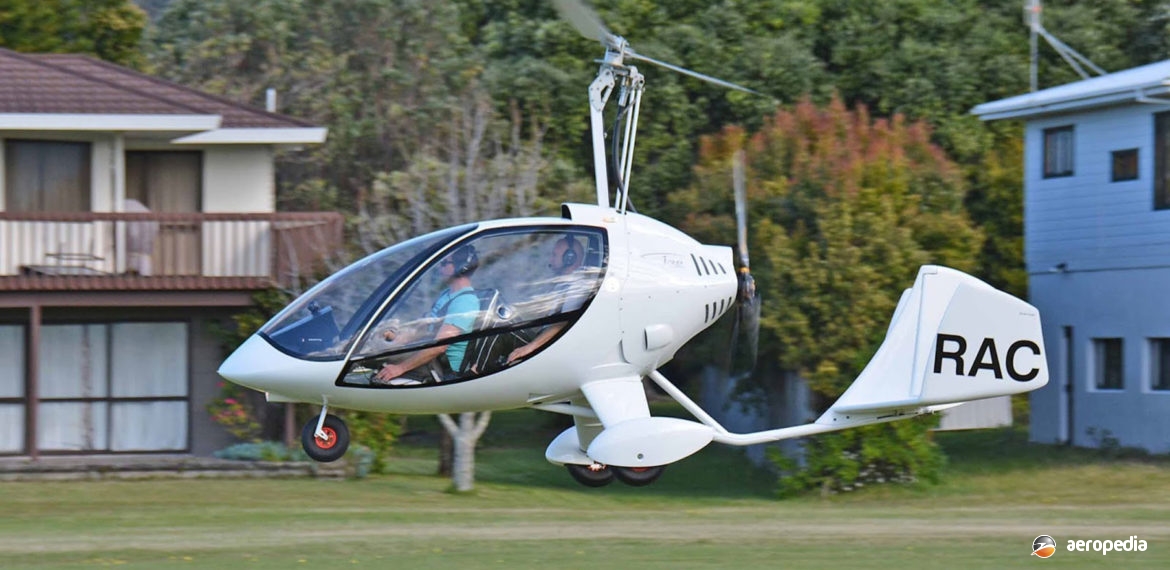Photograph:
Delta Trikes Aviation J-RO gyrocopter ZK-RAC (c/n 051) at Pauanui, New Zealand in September 2017 (Richard Currie – NZCIVAIR)
Country of origin:
France
Description:
Two-seat light sport gyrocopter
Power Plant:
One 84 kw (115 hp) Rotax 914 Turbo four-cylinder horizontally-opposed liquid-and-air-cooled engine
Specifications:
- Overall fuselage length: 5.2 m (17 ft)
- Length with rotor: 8.5 m (27 ft 8 in)
- Overall width: 1.95 m (6 ft 4 in)
- Overall height: 2.62 m (8 ft 7 in)
- Never exceed speed: 180 km/h (112 mph)
- Cruising speed: 160 km/h (100 mph)
- Minimum speed: 45 km/h (28 mph)
- Range standard fuel: 500 km (311 miles)
- Range with optional fuel: 800 km (497 miles)
- Landing roll: 30 m (98 ft)
- Take-off roll: 90 m (295 ft)
- Take-off distance over 15 m (50 ft) obstacle: 200 m (656 ft)
- Landing distance over 15 m (50 ft) obstacle: 100 m (328 ft)
- Fuel capacity: 70 litres (15 Imp gals)
- Fuel capacity optional: 90 litres (18 Imp gals)
- Empty weight: 268 kg (591 lb)
- Loaded weight: 560 kg (1,234 lb)
History:
Development Technology Aero (DTA), later known as Delta Trikes Aviation, was founded in France in 1990 by Jean-Michel Dizier to produce a range of trikes. Machines were developed to meet aerial work requirements, including agriculture, territorial tracking and pipeline work. First model produced was the Voyageur 912 which was fitted with a 60 kw (80 hp) Rotax 912 engine. This model was used by pioneers in adventure trike travel and was considered a robust machine. The range was subsequently increased to the Evolution, the Feeling and the Voyageur II, the latter considered to be the ultimate cross-country trike.
Later the Company added a gyrocopter to its range which became known as the J-Ro and was introduced to the market in 2016. The machine had an epoxy shell with a carbon fibre engine hood, the windshield and doors being constructed from 6S241 plexiglass. The fuselage was constructed from 25CD4S steel with 304 stainless steel. The undercarriage was constructed from Dural 7075 and was fitted with a Beringer nose wheel and Beringer hydraulically-braked rear wheels. The rotor was constructed from extruded T6106T6 aluminium and had a diameter of 8.5 m ((27 ft 8 in). It had an Averso rotor head and pre-rotation was by a Kevlar drive belt and flex shaft.
The J-Ro machine could be fitted with either the Rotax ULS912 engine or the turbocharged UL914 with a torque limiter, a thermo oil valve, a stainless steel exhaust and a Duc Windspoon propeller. Seating was provided for two in tandem.
First example seen in this region became ZK-RAC (c/n 051) in New Zealand, being assembled in February 2017 and registered to Back Country Honey Ltd of Tomoana, Hastings.

